The Studio Potter
It is production that gives “roots” to work and craftsmanship says Gerry Williams, one of the organizers of a recent exhibition that calls our attention to the potter’s life in American today.
By Nancy Means Wright
Viewed as a whole, the “Studio Potter” exhibition at the Vermont State Craft Center at Frog Hollow in Middlebury (March 30-May5) was a veritable sea of pots, three dimensional like the waterfall outside the gallery windows. An old waterwheel, still wedged, according to legend, in the stone depths of this old mill, could almost be felt to churn again from the vibrancy of the work. A joint undertaking of Ann Roth, executive director of the center, and Gerry Williams, editor of The Studio Potter magazine, the exhibition featured the ceramics of 11 masters. Photographs and personal writings bore witness to the potters’ home surroundings, their visions, their way of life. The forms and concepts varied, but the vigor of the work, its art, and above all its functional intent, connected these potters to one another.
“All of us here have agreed that the most important thing is to know where our roots are,” said Williams during a panel discussion on how to make art and ends “balance” that preceded the show’s opening. Defining the “studio potter” as one who “works in clay through choice or education, whose professional environment is a work-study space, and whose primary occupation is the production of functional objects,” Williams said he had brought these particular potters together because of the high caliber of their work, their professional commitment, their courage to be independent of the academy and pursue lifestyles of their own, and their geographical diversity.
In some ways the 11 potters lead remarkably similar lives—easygoing, yet hardworking. Their lives seem inseparable from their work as they coax their pots through from beginning to end, from nothing to something. They exercise “the energies of mind and soul as well as body,” in the words of William Morris, the spokesman for the English Arts and Crafts Movement.
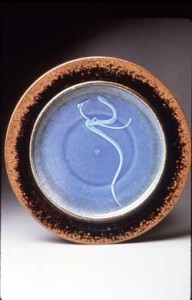 Frank Boyden and Tom and Elaine Coleman have their studios in rural Oregon. Boyden pulls his “cast of characters” out of the preserved estuary where he lives “surrounded by silence and the constant change of tide and water.” A raven picks at the precise bones of a salmon in a raku-fired platter fit for a Neptune banquet; birds and fish float in the watery womb of the Birth of the Birds jar. Like Boyden, the Colemans, who for 20 years have been making porcelainware in a converted cow shed outside their restored farmhouse, merge air, earth and water in their work. Elaine captures a crane on an exquisite incised celadon teapot, while Tom offers a wide variety of pieces, from polished porcelain with abstract designs to a black cauldron whose gleaming depths might contain the “boil and bubble” of a witches’ brew.
Frank Boyden and Tom and Elaine Coleman have their studios in rural Oregon. Boyden pulls his “cast of characters” out of the preserved estuary where he lives “surrounded by silence and the constant change of tide and water.” A raven picks at the precise bones of a salmon in a raku-fired platter fit for a Neptune banquet; birds and fish float in the watery womb of the Birth of the Birds jar. Like Boyden, the Colemans, who for 20 years have been making porcelainware in a converted cow shed outside their restored farmhouse, merge air, earth and water in their work. Elaine captures a crane on an exquisite incised celadon teapot, while Tom offers a wide variety of pieces, from polished porcelain with abstract designs to a black cauldron whose gleaming depths might contain the “boil and bubble” of a witches’ brew.
The coulees of western Wisconsin roll past the 19th century log cabin where Randy Johnston throws wood-fired pots, such as a tall vase of ash and feldspar glaze with iron checks or an ample bowl with earth-brown rope inlay. To David Shaner, “part of my soul lies in the mountains and lakes of Montana.” There he creates wood-or propane-fired pots and slabs; a wand of wild grass or the coppery red of a western sunset shimmer on the side of a teapot or bowl. The noon sun of New Mexico shoots its spectrum of colors through the pots of Jenny Lind. Animals that roam her farm and garden are reflected on china-painted porcelain: horses stampede around the surface of a teapot and geese stretch their necks in the blue, black and gold Goose Bowl.
On the fringe of academic institutions, yet decidedly artists in non-residence, are Cynthia Bringle and John Glick. Bringle, who stayed on at Frog Hollow to conduct a three-day workshop after the panel discussion, has since 1965 maintained a studio on the wooded edge of the Penland School of Crafts in North Carolina. Of the dozen or so of her pieces in the exhibition, she favors the whimsical raku-fired jars that might have held cookies at the Mad Hatter’s tea party. Glick, who has been potting “since the early stages of the crafts rebirth in the 60s,” works in a large barn outside his restored Michigan farmhouse, not far from the Cranbrook schools. His “quite simple” way of life revolves around “values rooted in good personal relationships.” The fluted rims and antique mauves and yellows of his bowls, mugs and platters give a solid Victorian cast to his work.
Closer to “the madding crowd” is Todd Piker, who lives in Connecticut. Among his wood-fired pitchers, teabowls and plates was the largest piece in the exhibition—a great earth-colored “bottle,” with looping handles and a drop of blue glaze on its side, like the preserved wing of a dragonfly. The only city dwellers represented were Richard Aerni and Michael Frasca, who share a studio and courtyard on the fringe of downtown Cincinnati, Ohio. Their large ash-glaze urns and vases seems to fit the scale and reflect the textures and architecture of the surrounding multiple-story structures, with their “Italianate cornices and decorative cast-iron storefronts.” Aerni and Frasca are established in their community. Dedicated to their craft, impelled to it by some inner need, not one of the potters would trade his lifestyle, as Shaner maintains, “for anyone else’s.” Not that making pots for a livelihood has been without struggle, he allows, both physical and spiritual.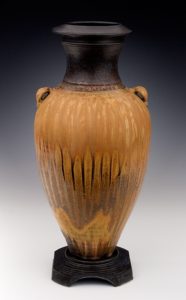
And the struggle goes on. “I was a romantic 14 years ago,” admits Johnston, whose concern that “it would be a long time before recognition” has been borne out. To attain a “satisfying level in one’s work,” says Glick, “is an elusive goal. The ‘end’ changes all the time.” Lind hasn’t yet found the end. “I am no longer swayed by public opinion, and that may be a goal attained.” The Colemans thank God for the struggle. They find that their work “constantly enters new phases” because of it. And though Boyden recognizes the risks and frustrations, he says, “It’s been a lot of fun. I work very hard. If you want to call that a struggle, it is.” Boyden finds potting wonderful. One is “dealing with elemental forces that no other field provides.” Shaner agrees. “To be able to make something beautiful with one’s hands, something useful out of mundane materials—earth, water, fire—to be able to work at home and watch your children grow, are a few of the rewards for this struggle. Aren’t I a typical potter?”
Though they may think of themselves as typical, and as belonging to, in Colemans’s words, the “real brotherhood” of potters, these 11 are unique in having risen out of the “snake pit, the Saturday marketplace,” and joined that rare company of independents—those who can make their own choices. Bringle has chosen to work alone, while Piker has a bustling workshop full of apprentices. Aerni and Frasca sign their pieces as one person; the Colemans share a kiln, but each remains autonomous as a potter. Glick considers his work to be more varied, less predictable than the average potter’s, while Boyden feels that his work encompasses a broad range of media and techniques—steel, lithography, drawing on clay.
This independence, of course, can lead to sacrifice. “It’s selfish to be an artist,” says Tom Coleman, who with some guilt sees himself as “that crazy man in the studio making pots,” apart from his sons. Lind and Elaine Coleman have experienced conflicts of priority as they balance the roles of potter and mother. Once a night person, Johnston rises at six a.m. to be with his preschool sons. Although his work comes first, the family has been part of his growth as an artist. Sometimes an interruption “sparks an interesting idea.”
But if there has been sacrifice, and backache—Coleman lifts weights to overcome this potter’s plague—none of this group has succumbed to “burnout,” although the possibility hangs over the artist’s head like a sword of Damocles. Piker has witnessed the phenomenon in students “anxious to be superstars.” His apprentices, of course, ease his own backache by “getting out the pots.” “Unwise planning can end in burnout,” suggests Aerni, who sees scheduling one’s time as an art. Breaking out of the “hundred mugs and handles” routine saved the Colemans.
And these artists want to be members of their community. Most reach out through their craft. Piker, who tries to be accessible to the public, has designed a memorial plate for his local fire department. Bringle is on the board of several crafts agencies and is available to the students of Penland. Aerni and Frasca take an active role in the “green-up” of their neighborhood. Boyden, who feels that an artist should be a “standard setter” and assume a strong role in the community, has established a nonprofit retreat for the study of art and ecology. Although Shaner warns that the “artist must concern himself with the passions of the times,” he and the others do not involve themselves in politics. After all, as Williams maintains, “to be a studio potter today is in itself a protest against the dehumanization of society.”
“Once you’ve proved that you’re able to support yourself,” Aerni observes, “competition seems to lessen.” “I can’t pretend I’m not a product of the competitive system,” says Piker, “but it’s not part of my impetus. Yet competition keeps me going.” Tom Coleman prefers to organize his own shows in order to secure top display space, while Lind, who finds competition among galleries and artists “destructive,” gives instructions on how to display her pots. With a good body of work, insists Boyden, it should be no problem for an artist to demand that a gallery give adequate space. Coleman, who is uncomfortable with the “pressure of being a forerunner,” is glad to have solid competition. “We’re not self-promoters,” Elaine says, “but things happen for us now. People come to us.”
Most of the potters have been victims of plagiarism. Students learn by copying, Elaine concedes, but professionals should know better. Boyden is “shocked at the way they try to copy Tom Coleman. I don’t see how a craftsman has the guts to do that.” Now Coleman tries to keep his work “too 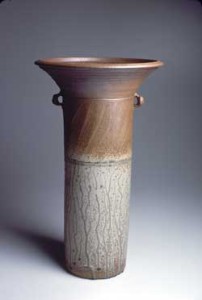 difficult” to copy. Bringle says, “By the time they figure it out, I’m beyond.” Yet all are willing to share formulas. “There are no secrets,” says Bringle, although she is less open with potters in her area to avoid “all of us using the same glaze.” And Piker gives them out only “if someone shows true interest and is on my wavelength.” Boyden, who learned his craft through fellow potters, would share his knowledge without reservation. “Nobody’s going to do what I do with it.” Lind was bothered by plagiarism before she realized that “ideas are bountiful—the more I give to others, the more I get in return.”
difficult” to copy. Bringle says, “By the time they figure it out, I’m beyond.” Yet all are willing to share formulas. “There are no secrets,” says Bringle, although she is less open with potters in her area to avoid “all of us using the same glaze.” And Piker gives them out only “if someone shows true interest and is on my wavelength.” Boyden, who learned his craft through fellow potters, would share his knowledge without reservation. “Nobody’s going to do what I do with it.” Lind was bothered by plagiarism before she realized that “ideas are bountiful—the more I give to others, the more I get in return.”
None of the potters is consciously preoccupied with “being on top.” “I don’t function in those terms,” says Glick. Nor do they seem especially concerned with the question, Am I an artist or a craftsman? Production or studio potter? According to Boyden, the latter term was coined a decade ago by Williams with the hopes that the change in nomenclature would improve the public’s perception of potters.
“Call me anything you want,” says Bringle, who considers herself a production potter because she produces for a living. “I hope I’m an artist as well as a craftsman.” Production pottery is the backbone of today’s work, says Tom Coleman, to whom only one out of many throws becomes “art,” and who favors the “studio potter” label. To Johnston, who prefers that “others define who I am,” art is “a moment” that happens during the process of working. “Any medium can be art,” contends Lind, “if it conveys the inner spirit of the maker.”
In Lind’s definition, all of these exhibitors are artists. “But craftsmanship is a matter of extreme pride,” Boyden adds. “It is presumptuous,” argues Piker, “for us to try to define ourselves in our own lifetime.” All agree with Bringle’s pragmatic suggestion that potters should leave the question of semantics to the critics and editors, and “let the pot speak for itself. Let us get on with our work.”
The question uppermost in the minds of these potters, then, is not what they are, but what they do. How can they achieve the delicate balance between production and creativity, aesthetics and economics? Johnston wholesales a limited number of pots to Neiman-Marcus, as well as to some private corporations, but considers himself a poor salesman. Galleries, he feels, bring recognition but little profit. His income derives largely from four pottery sales a year in his showroom. Glick, who also prefers to be “alone and potting,” sells mainly in his showroom at Plum Tree Pottery. Bringle, who used to wholesale two-thirds of her work, now sells only 25 per cent through shops and galleries. Although she attends craft fairs, she finds the museum and collector’s market limited, and sells most of her work out of her showroom.
Shaner, whose work is in museums and private collections, in national and international exhibits, likes to know his customers. Boyden markets most of his work to a network of galleries, yet considers himself a businessman as well as an artist. He used to have a hard time selling until he realized that “if I didn’t do it, no one would. So I knuckled down and did it.”
Though Tom Coleman has been the subject of a book—The Mudpie Dilemma (1978) by John Nance—he finds it hard to sell himself; he still hasn’t achieved the magic balance, he feels, after 20 years of potting. The Colemans sell their work mainly to private collectors through exhibitions; yet Tom is wary of the “Madison Avenue hype” in some galleries. “I don’t know where I fit in.” Galleries also account for the larger part of Lind’s sales, along with shops and special orders. Yet to make ends meet, she and her husband have launched Animals and Co., a menagerie of china-painted teapots designed by Lind, several of which graced the Frog Hollow exhibit.
Aerni and Frasca opened Spring Street Pottery three years ago, after waging a struggle to change Cincinnati’s zoning regulations. They now divide the work “as mood and schedule permit,” but always make sure that “both have an impact on the production of a piece.” Most of their pots are sold wholesale to shops, galleries, architects and decorators, with contacts 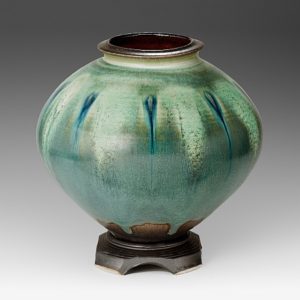 coming through American Craft Enterprises fairs.
coming through American Craft Enterprises fairs.
Working on the largest scale of all is Piker, whose Cornwall Bridge Pottery produces some 30 tons of stoneware a year. Although he operates a retail shop and exhibits work in fairs and museums, he sells the bulk of his pots wholesale to Bloomingdale’s or to a local nursery for which he makes 5,000 hanging planters each year. Maintaining that art and commerce “contribute to each other’s survival,” he avoids galleries. “They’re mostly into markup,” he claims, “not volume. I’d get poor promoting myself.” His prices are low, he submits, “way under, hardly covering cost.”
Pricing is a matter of “feel and experience” to the Colemans, whose porcelains command robust prices. “It depends largely on how a piece turns out,” says Tom, who loses 10 to 40 percent of his work in the kiln. “I raise prices now when appropriate,” says Boyden, who once raised his, he quips, “every time U.S. Steel went up.” Lind often compares herself to other potters, or asks galleries to suggest the cost. Johnston follows the philosophy of Warren MacKenzie and Bernard Leach—affordable pots for daily use. Shaner, who depends on “grass roots support,” charges what those living around him can afford. “Still, as I fill my gas tank, I realize that no price an artist charges is too high, if it is good work.” Bringle tells people, “If you like the cheaper one best, buy it. It all comes down to point of view.”
Although it triples her work load, Bringle allows for a client’s taste in color or shape of dinnerware or lamp bases. “A potter ought to be connected with other personalities. If they don’t buy, at least I’ve made inroads into their thought process.” Johnston is concerned that the buyer respond to the “innate spirit of the work.” Educating the public is not such a problem for him because his work, like that of Piker and Shaner, lies in the tradition of Hamada and Leach.
Because a flawed piece can discourage a customer, Coleman suggests workshops on “how to buy a good functional piece.” Glick and the Colemans offer lectures and workshops, and are generally available to the public. Boyden finds educating the public to be a complex process. “Self-promotion,” he says, “presumes that you feel you’re doing something wonderful. But if you put out, over a broad area, fine work that gets into people’s houses, the word spreads.” He feels that education should be the priority of galleries too, and he claims that some galleries refuse even to give out an artist’s address.
In the end, the balance between aesthetics and economics is seldom fully achieved. “It depends on who’s reading the books,” says Piker. Nevertheless, at 31, he feels satisfied with his living and no longer seeks grants as he did in the “early days.” Now he would turn down a grant if it were offered. Aerni and Frasca find wholesaling a “nice steady way to make a living. The pursuit of grants, publicity and recognition have never been of great importance.” Shaner, Glick, Bringle, Johnston and Boyden have all received grants, yet offer workshops to supplement their income, while Boyden also works in other media. (His 10 black and white lithographs added depth to the show.) Bringle makes a comfortable living, but claims to lose money through workshops, which draw her away from the studio. Lind, Johnston and the Colemans still find themselves “on the wrong side of the balance.” “There’s not enough left after expenses,” insist the Colemans, who are now beginning to look into grants. For Johnston, who offers workshops and builds stone chimneys for a local architect, there is “virtually no living” for a family of four. He is impressed by the support for the arts in Norway and Japan. “I’d like to see that here.”
Yet financial concerns do not stand in the way of growth for those potters. If money were no problem, would they take more risks? Of course, say the Colemans who admit that “the check in the mail spurs you on.” Without it, there is the sense of failure. Glick imagines himself as “probably more risk-taking” now than the average potter, while Lind, who relishes change, is more “apt to leap and then look back.” Her work, she feels, has not been “as readily acceptable to the average buyer” in recent years. “But being a potter for money is silly,” says Tom Coleman, who works more for himself than for “someone else’s profit.” “I’d continue to sell no matter what,” declares Boyden, who takes pleasure in knowing that people enjoy his pots. Given all the wealth in the world, he’d still produce.
It is production, then, as Williams emphasized in the panel discussion, that gives “roots” to work and craftsmanship. “I see production related to the concept of function.” There are few pieces in the show that do not have form and function as a primary impetus. “Even a coffee cup,” insists Johnston, “must be pleasant to the hand, comfortable to the lip…and at the same time contain a magic gestural quality.” To Aerni and Frasca, “functionalism has determined much of the design element in the work.” To Lind there is “no division between function and artistry. A teacup is a restricted form if you plan to use it. But then so is a canvas. It is our limited understanding that would make one better than the other.”
There are always temptations in production, “but one must keep one’s 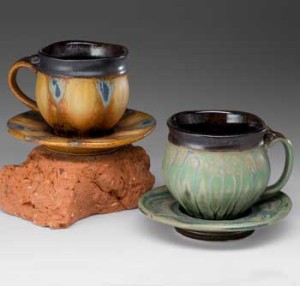 standards high,” Boyden warns. Although overdecoration comes back to “haunt” them, there are no seconds for the Colemans, who break pots that are not top quality in their view. As for Piker’s 5,000 planters, “If I thought I was sacrificing quality, I wouldn’t make them.” Johnston learned a lesson in Japan, when Shimaoka’s foreman had 500 of his teabowls destroyed. “To me they were nice cups. But he wasn’t going to accept less than the standard.” This system is good and bad, according to Johnston, who feels that be “deviating from dictated quality, you might stumble across something of interest.” True to his work, he engages in a “constant reassessment” of it, feeding back new ideas. “I never think about innovation as such.”
standards high,” Boyden warns. Although overdecoration comes back to “haunt” them, there are no seconds for the Colemans, who break pots that are not top quality in their view. As for Piker’s 5,000 planters, “If I thought I was sacrificing quality, I wouldn’t make them.” Johnston learned a lesson in Japan, when Shimaoka’s foreman had 500 of his teabowls destroyed. “To me they were nice cups. But he wasn’t going to accept less than the standard.” This system is good and bad, according to Johnston, who feels that be “deviating from dictated quality, you might stumble across something of interest.” True to his work, he engages in a “constant reassessment” of it, feeding back new ideas. “I never think about innovation as such.”
Here he touches on one of the major issues raised by the show. What is innovation? How does one distinguish it from mere novelty? Does it mean “more sculptural work?” Bringle asks, “or bright colors? I don’t know.” “As the potter moves toward the collector’s market, the vessel gives way to sculpture,” says Williams, defining “university art” as a concern for the “idea of a pots, and not the pot itself.” True innovative work, he feels, should deal with new uses of tradition and function. “Cut off the root and where are you?”
The movement of “basic pottery toward ‘art’” is a major concern for the Colemans, who have been turned away from certain galleries because they make traditional pots. “Conscious innovation: seems an affectation to Piker, who once felt cut off by the establishment for his supposedly “derivative” work. “Mine was an economic decision,” he says, “to go my own way.” He refuses innovation for it’s own sake. “The more experienced we become,” he says of his work, “the further back in time we seem able to go.”
“Looked at in the light of the anthropological and archaeological past,” observes Boyden, formerly an art historian, “we’re not so special. The wonders of the ancient potters are similar to our wonders.” “Indian pots,” Lind echoes, “weren’t made for someone’s basement collection.” Like Boyden, she doesn’t worry about innovation: “I just work, and things change.”
And so there 11 potters move forward in a kind of “evolutionary process” that is “akin to nature,” as Aerni suggests, aware of trends and cycles in the fickle swings of art and society, but adapting only the genuine, and not losing sight of the basis.
Tom Coleman finds himself “loosening up,” using less decoration, more asymmetrical shapes. With “all that new technology out there, you have to reach deeper each time.” Elaine will try slabs and freestanding pieces. Lind, who delights in surprise, finds her new work “less painterly.” Bringle is moving in the direction of larger pieces, more raku. “I want to be somewhere else with the next kiln load.” Concerned with a shortage of time, not ideas, Johnston is experimenting with more geometric forms, rougher surfaces. A wood firer, he could end up “an anachronism in a technological society—suitably poor, but loving every minute of it.”
“What we have here,” said Bringle, taking an objective look during the “Studio Potter” opening, is “their newest work, beyond what they did a few years ago. Does it go with the trends? No. this is beautiful, solid work.” Williams agreed. “if the show isn’t innovative in the university sense, it is involved with the integrity of the individual, the freshness of personality.”
No one could view these pots without “catching his breath,” in the words of Hamada. And to the well-tuned ear, the wheel could be heard turning in the deepest heart of the craft center. For while the viewer was gazing, the potter was down there (or in Oregon, Montana, New Mexico), working to music perhaps, or to the sound of his own voice yelling, but “getting on with the pots.”
